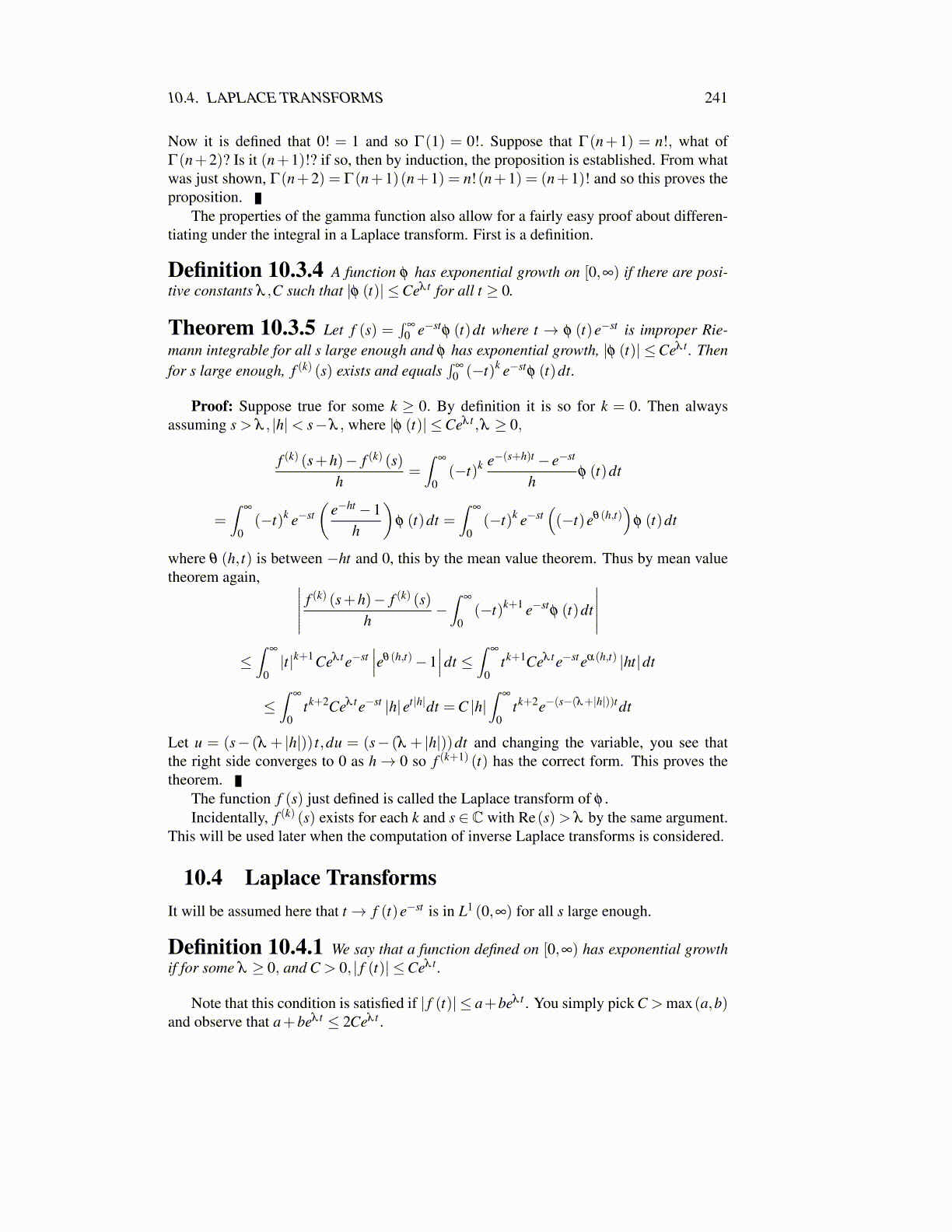
10.4. LAPLACE TRANSFORMS 241
Proposition 10.4.6 Let f ,g have exponential growth and be continuous. Then f ∗ ghas the same properties. Also L ( f ∗g)(s) = L ( f )(s)L (g)(s) for all s large enough.
Proof: Consider the second claim. Say | f (t)| ≤ Ceλ t , |g(t)| ≤ Ĉeλ̂ t . Letting µ ≥max
(λ , λ̂
),∣∣∣∣∫ t
0f (t−u)g(u)du
∣∣∣∣≤ ∫ t
0CĈeµ(t−u)eµudu≤CĈteµt ≤CĈe2max(µ,1)t
Now consider the claim about the convolution. Let s> 2max(µ,1)≡ γ . By Lemma 10.4.5,∫ R
0e−st
∫ t
0f (t−u)g(u)dudt =
∫ R
0
∫ R
ue−st f (t−u)g(u)dtdu
=∫ R
0e−sug(u)
∫ R
ue−s(t−u) f (t−u)dtdu =
∫ R
0e−sug(u)
∫ R−u
0e−sv f (v)dvdu
=∫ R
0e−sug(u)
∫ R
0e−sv f (v)dv−
(∫ R
R−ue−sv f (v)dv
)du
Therefore, ∫ R
0e−st ( f ∗g)(t)dt =
∫ R
0e−sug(u)du
∫ R
0e−sv f (v)dv
−∫ R
0e−sug(u)
∫ R
R−ue−sv f (v)dvdu (10.11)
Now ∣∣∣∣∫ R
0e−sug(u)
∫ R
R−ue−sv f (v)dvdu
∣∣∣∣≤ ∫ R
0Ĉe−(s−γ)u
∫ R
R−uCe−(s−γ)vdvdu
≡∫ R
0Ĉe−λu
∫ R
R−uCe−λvdvdu≤CĈ
∫ R
0e−λue−λ (R−u)du =CĈe−λRR
which converges to 0 as R→ ∞. Therefore, the last term on the right in 10.11 converges to0 and so, taking a limit as R→ ∞ in 10.11 yields L ( f ∗g)(s) = L ( f )(s)L (g)(s).
That which is most certainly not obvious is the following major theorem. This is omit-ted from virtually all ordinary differential equations books, and it is this very thing whichjustifies the use of Laplace transforms in solving various equations. Without it or somethinglike it, the whole method is nonsense. I am following Widder [26]. This theorem says thatif you know the Laplace transform, this will determine the function it came from at everypoint of continuity. The proof only involves the theory of the integral which was presentedin this chapter and Stirling’s formula. Also, it would easily generalize to functions havingvalues in some normed vector space. First is a lemma.
Lemma 10.4.7 Let a > 0 and b > 1. Then limk→∞1k!∫
∞
bk vke−(1− ak )vdv = 0.
Proof: First change variables(1− a
k
)v = kx. A few computations show that the above
integral is 1k!
kk+1
(1− ak )
k+1
∫∞
(1− ak )b xke−kxdx. Now let 1 < b̂ < b. Then for k large enough,